Sources
000 General Records
001 Dictionary of Welsh Biography. Website: https://biography.wales. Specifically:
- Rev. Christopher Bassett (1752-1784)(Junior - the methodist preacher and son of Christopher and Alice Bassett of St Athan)
- Robert Holland (1556-1622)
- Holland families
002 Wills and Probate Records (and also those bonds which addressed how the debts of someone who died was to be resolved by the Executrix of the Will, generally accompanied by an inventory of the assets of the deceased):
- Philemon Williams 1856 (NLW)
- Philemon Williams 1750 (NLW)
- Margaret Williams 1824 (NLW)
- Christopher Bassett 1809 (NLW)
- John Holland 1754 (NLW)
- Elizabeth Holland 1751 (NLW)
- Thomas Andrews 1711 (NLW)
- Rise Holland 1749 (NLW)
- Thomas Wall 1806 (Bristol Archives)
- Rev. Edward Williams 1724 (NLW)
- Nicholas Holland 1720 (NA)
- William Harry 1720 (NLW)
- Elinor Butler (bond and probate extract) 1723 (NLW)
- Harry William 1725 (NLW)
- Elizabeth David (Bonvil) 1747 (NLW)
- Mary William (Snr) 1748 (NLW)
- William Mangel 1796 (NLW)
- William Mangel bond 1777 (NLW)
- Edward Walters 1761 (NLW)
003 Birth, baptism, death, census and marriage records - Glamorgan Family History Society (GFHS) and also from online sources eg FamilySearch.org, findmypast.co.uk or ancestry.co.uk. Plus later records from UK General Register Office. Examples:
- 1814 Philemon Williams m. Mary Thomas at Ewenny Priory Church.
- 1856 Philemon Williams of Wick to 'Elinnor' John in Bettws church (Ref: Bridgend & Cowbridge - Vol11A, p.469).
- 1856 Death certificate for Philemon Williams (Ref: Bridgend Vol11A, p.258)
- 1874 Noah Williams birth certificate (ref: Q2 Vol11A, p.590, 148)
- 1892 Death certtificate for Philemon Bassett Williams (Ref: Bridgend Vol11A, p.514)
- 1911 Noah Williams m. Sarah Lewis, St Johns church, Cardiff (ref: Vol11A, p.612).
004 Memorial Descriptions. Including:
- Bassett's at St Tathan churchyard, St Athan (GFHS)
- Rev Edward Williams at St Dochdwy, Llandough-juxta-Cowbridge (GFHS)
- Noah Williams (1956), wife Sarah Ann (1974) and Philemon Bassett Williams (1984). Wick Baptist/ Unitarian chapel.
005 Marriage Licenses/ Bonds
Between 1700 - 1823, while most couples married through 'banns' (where their names were called on 3 successive Sundays) an alternative was to marry by license. Marriage by license was for those who were in a hurry and/or for those could afford the cost (from 5 shillings to a couple of pounds, so this was a symbol of social status). It was also for those who attended non-conformist churches - prior to such churches being officially able to hold their own weddings (from 1837). The marriage license had an associated marriage bond where the couple allege there are no impediments to the marriage and a penalty is set, deliberately high, to deter irregular marriages. The penalty is not paid unless the terms of the bond are breached. If either of the parties are under 21, then parental permission was required. Examples:
- 1804 Philemon Williams to Ann Smith, both of St Brides Major. Marriage Bond with penalty to pay Lord Bishop of Landaff £200. (NLW)
- Williams, Philemon, wid., St Brides Major, Glamorgan to Thomas, Mary, Sp. Ewenny. Glamorgan 1814. (NLW)
- Williams, Bassett, bach. St Brides Major, Glamorgan to Lougher, Mary, sp., Monknash, Glamorgan 1810. (NLW)
- 1784 William Thomas of Ewenny to Mary Hopkin of St Brides Major. Marriage Bond with penalty to pay Lord Bishop of Landaff £200. (NLW)
Marriage Settlement/ Indenture for Thomas Jenkin and Ann William of Pembrokeshire, 1807. In this settlement, Thomas Jenkin gives all his household goods, furniture in his dwelling house to Henry William and Thomas Jenkin, for a consideration of 5 shillings. Similarly his wife to be, Ann William gives all her goods, chattels and livestock to the same Henry William and Thomas Jenkin for a consideration of 5 shillings. A likely explanation for this (a kind of early pre-nup agreement) is that:
- Up to 1870, the law held that everything belonging to the woman passed to her husband on their marriage.
- However a widow had a right to a third of her late husbands property (her 'Dower' rights). A way round a wife's dower rights is to pass the legal title of properties and goods to a 'dower trustee' such that on the man's death everything was held by the trustee/s.
- In this case, Thomas Jenkin had a son, William Jenkin, from a previous marriage. Therefore this settlement may allow for him to inherit everything.
Marriage bonds are listed for the following (but the records themselves have been lost):
- 1776, William/ Bassett (Bristol Archives)
- 1745, Bassett/ Holland (Bristol Archives)
006 Birth, Death and Wedding certificates, including:
- 1911 Wedding of Noah Williams and Sarah Lewis, St Johns Church, Cardiff.
- 1837 Death of Christopher Basset Williams
- 1862 at Wick St James church - Baptism of Jennet Williams to Philemon (farmer) and Anne. Address "Cae Coedcae, Wick".
007 Glamorgan Quarter Session Rolls (Glamorgan Archives).
008 Patronymic naming systems essentially derived surnames from the fathers christian name. It is common in old welsh family names where 'ap' means 'son of' and 'verch' means 'daughter of'. Further information given in Powell AA, GFHS journal 8 Dec. 1985. "The Patronymic naming system and its effect on geneological research techniques".
009 CCed - Clergy of the Church of England Database, held online. Includes:
- Edwardus Williams of St Brides, Co. Glamorgan. Educated Jesus College 1698 (age 19), rector for Michaelstone-le-Pit 1704 and Llandow 1708. Rector at Llandough-juxta-Cowbridge from 1708.
010 Anno Regni fecundo Georgii III. Published 1761, London by Parliament. Commissioners for .. a Land tax for 1762. Under Glamorgan it lists:
- William Bassett & Christopher Bassett
- Robert Jones of Fonmon
011 Antiquae Lingae Britannicae Thesaurus: Being a British or Welsh-English Dictionary by Thomas Richards (Curate of Coychurch), 1753. With a Preface by his Royal Highness the Prince of Wales and including a brief introduction to the welsh or ancient British language. It includes a list of subscribers which includes:
- Rev. William Williams, Curate of St Mary Redcliff, Bristol
012 Old maps of Glamorgan reproduced with the permission of the National Library of Scotland. Website is https://maps.nls.uk/. Pitcot map is Glamorgan map XLIV surveyed 1877, 6in to mile.
013 Ogmore Manor - Court Rolls and Surrenders. The proceedings of the Ogmore Manor Court and associated court rolls and records are found in various places, and noting the earliest records are in latin:
- 1732-1740 DL 30/603/1
- 1793-1812 Court Rolls DL 30/603/2 (NA)
- 1773-1811 184 original and draft surrenders etc in Man. Ogmore ref: 117 (NLW)
- 1747-1800 (NLW) Surrenders and Admissions
- 1790 - 1890 (NLW) Surrenders and Admissions
These are essentially minutes of meeting held on behalf of the Lord of the Manor and document the changes made to leased 'copyhold' land (a form of customary land ownership) held by tenants within the Manor - the Lord of the Manor remaining the legal owner of the manor land. In return for leased land, a copyhold tenant was required to carry out specific manorial duties or services. The privileges granted to each tenant, and the exact services he gives to the Lord of the Manor, were described in the roll or book kept by the steward, who gave a copy of the relevant entry to the tenant. Consequently, these tenants were called copyholders. Each manor custom laid out rights to use various resources of the land such as wood and pasture, and numbers of animals allowed on the common. During their life the tenant could sometimes 'sell' the holding to another person by formally surrendering it to the lord of the manor on the condition that the lord regrant it to the 'buyer'. This three-party transaction was recorded in the manorial roll and formed the new 'copyhold' for the purchaser. Note copyhold land did not necessarily appear in a person's will as inheritance of such land was pre-determined according to the customs of the manor (Wikipedia - on copyhold).
014 UK Land Tax Redemption 1798, National Archives.
015 A possible reference to the land at Cae Caradog - where 12 acres of land in Wick was given to the church of St James in Wick. Reference: NLW archives.
"Gift by William de Lundoniis to the church of St. Michael [Ewenny] of the land of Valle, under the rock of Caradoc Mailtor, as Goda held it, the hill which Pagan Grossus held the land which appertains to Old-castle, adjacent to the stream from the land of Decacius and within the boundary of Gillibert de Turbervilla, viz., 12 a., given in presence of N[icholas], [1149-1183.] Bishop of Llandaff, and H[ameline], [1148-1179] Abbot of Gloucester, on condition that the Prior shall provide for service of the Chapel of St. James at Wica (? Wick), thrice a week, etc. Witnesses: Maurice de Lundoniis, William de Lundoniis, Pagan de Turbervilla, H[er]nald the priest, WI...] priest; Germanus, clerk;
Dated at London (under seal as above). By the counsel of the said Duchy. W. Heydon. Latin."
100 Specific Williams' Records
101 A Williams Family Bible
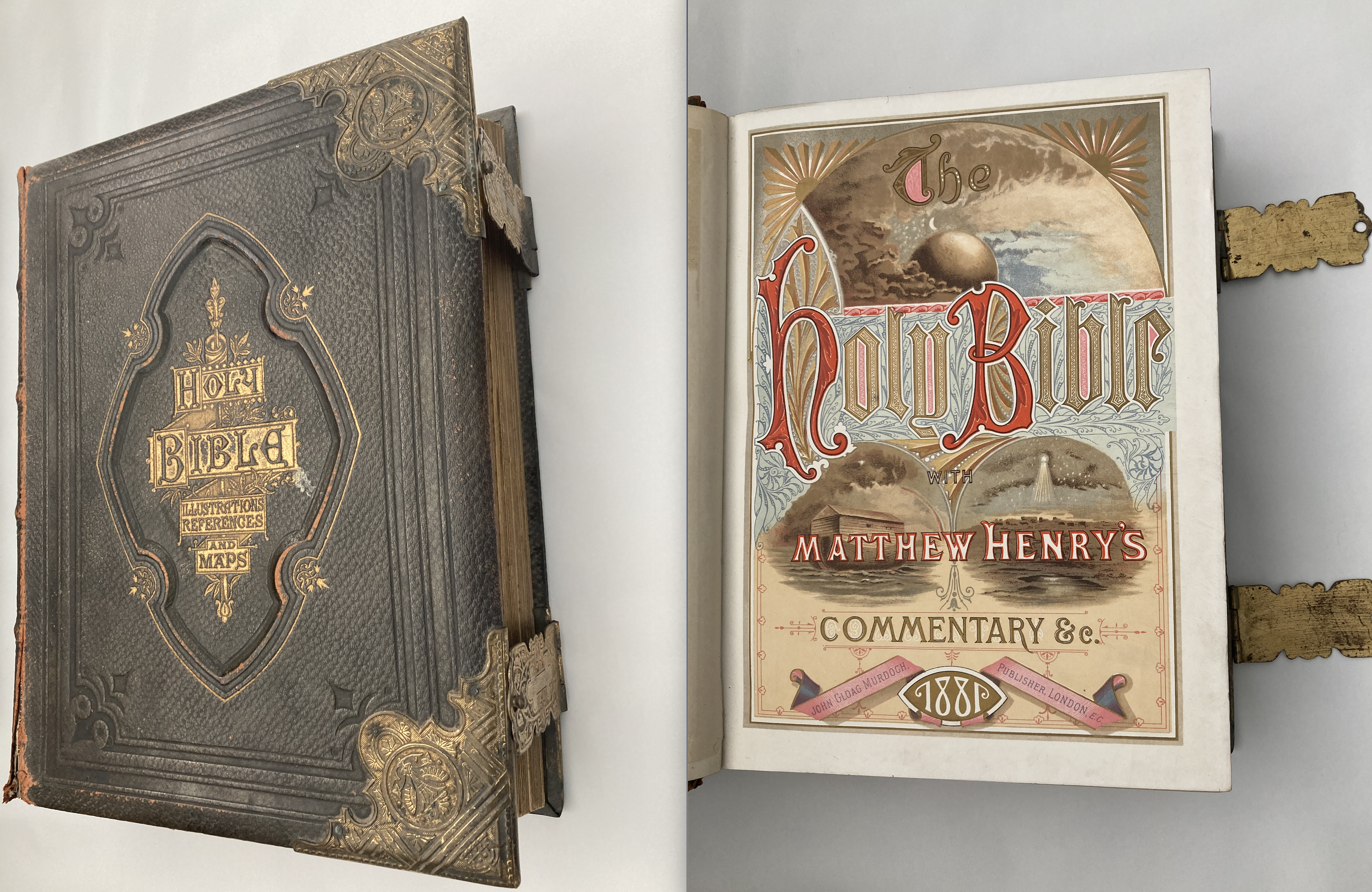
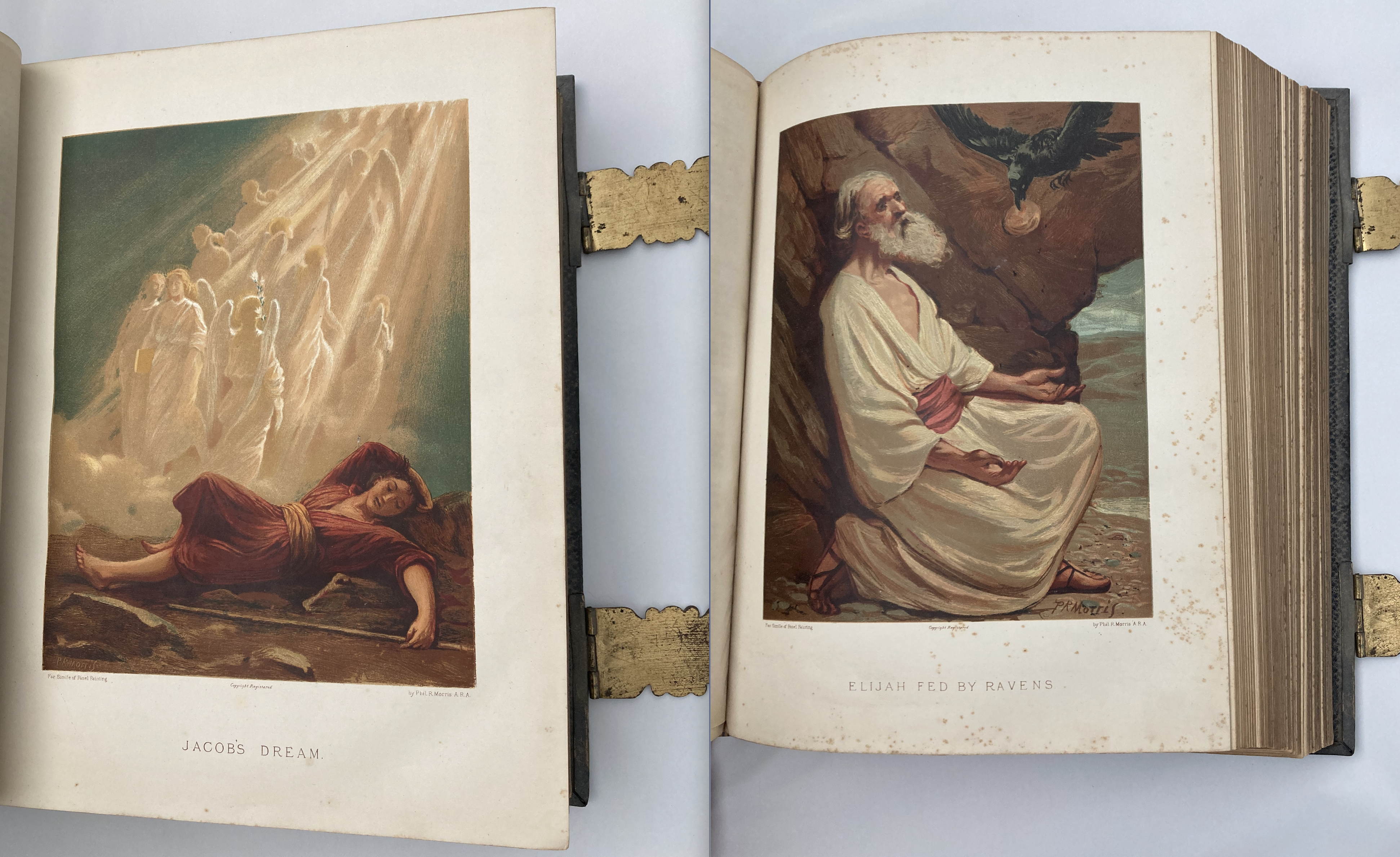
This Bible, published 1881, with colour plates, has the written inscription 'Jennet Catherine Williams - The Gift of her friend James Parsons'. It includes the following handwritten details of family events:
- Mary Lewis daughter of William & Ann Lewis married to Thos. J Jones the son of Edmund G. & Mary Ann Jones
- William Edmund James Jones born Ty Wick Green, April 22 1903
- Jennet Catherine Williams, born Cae Caradog Farm, Wick April 12th, 1912. Married to William Jenkin Rees at Wick St James Church by Rev. G E Kibblewhite, June 10th 1935
- Christopher Williams born at Cae Caradog Farm, Wick January 1st 1914
- Mona Margaret Williams born at Cae Caradog Farm, Wick April 16th 1917
- Mary Eleanor Williams born at Cae Caradog Farm, Wick Dec. 28th 1919. Married to Arthur R J Board at St James Church Wick by Rev. G E Kibblewhite
- Eva Doris Ann Williams born at Cae Caradog Farm, Wick March 2nd 1921
- Philemon Basset Williams born at Cae Caradog Farm July 11th 1924
- Marion Catherine Rees born at "Iona", Bynteg Gdns Bridgend June 25th 1937
102 Dunraven Estate Records – Deeds, Wills, Receipts, etc relating to 'Cae Caradoc', the property of the family of Philemon Williams. Held at NLW.
103 House of Commons. Accounts and Papers. Eighteen Volumes related to Assessed Taxes, Poor etc Sessions. Session 6 Dec. 1831 - 16 Aug 1832, Vol. XLIV provides details of Coroner payments made to Philemon Williams under County of Glamorgan.
104 1840 Apportionment of the Rent Charges in Lieu of Tithes in the Parish of St Brides Major with the chapelry of Wick annexed in the County of Glamorgan. By John Johnes, assistant tithe commissioner, 1840. NLW. Note: Rent charges to be paid to Christopher Rice Maunsell Talbot and the vicar of St Brides Major.
105 Merthyr Mawr Estate records - St Brides Major and Wick - DN/485, 486, 483, 484 (Glamorgan Archives). Prenuptual and Bond arrangements of 1787 relating to marriage of Robert Davies of Old Castle upon Alun and Margaret Davies - in which Edward Williams is a trustee and specifically acknowledged as being 'of Pitcot'. Edward would be around 40 years old at this point.
106 Defamation records against Philemon Williams (1714-1750), NLW arising 1738 - 1741. There are around 10 records detailing defamation brought by:
- Elizabeth, wife of Evan Philipp
- Mary George, spinster
- Mary George, wife of William George
107 The other Edward Williams, associated with Pitcot and the Ogmore Manor Court.
There were two persons called 'Edward Williams' at this time, and both are mentioned in the records of the Manor Court of Ogmore. The 'other' Edward Williams lived in Colwinston and is referred to as the customery heir of Edward Walters - a Gentleman who lived in Pitcot, was Sheriff of Glamorgan in 1754 and who was coroner for Ogmore:
- The 1761 will of Edward Walters [ref: 002] details some 42 specific payments to people and groups of people and then states: 'The residue of my fiscal estate I give and devise the same unto my sister Mary the wife of Thomas Bennett of Laleston, Surgeon, for and during the term of her natural life upon condition that she promise personally to live at my new dwelling house at Pitcot within the span of 12 months next after my decease and from and after our decease or after her default of residence at my said new dwelling house within the span aforesaid I give and devise the same unto my executors four finally named and the survivor of them in trust whoever that is to and for the use and behoof of Edward the son of Edward Williams of Colwinston aforesaid and his heirs. My said conditions permitting him and them from time to time to receive the rents and profits thereof to his and their own proper use forever subject nevertheless to the payment of all and singular my debts, legacies and funeral expenses etc.'
- The beneficiary of this will, Mary Bennett, had married into an even wealthier family, as Thomas Bennett her husband was a descendent of Thomas Turbervill of Ogmore and was himself Sheriff of Glamorgan in 1768.
- Records appear to indicate that this Edward Williams (1748-1803), son of Edward Williams, together with his wife Margaret (1748-1815) had 2 children, Eleanor/ Helena John (b. 1789 Colwinston) and Ann Jones (1779-1847) and that they stayed in Colwinston. Their tombstone at St Michael church, Colwinston says Edward William died 1803, age 55, Margaret his wife died 1815, age 67 and Ann Jones, their daughter died 1847 age 68.
108 Bond for Catherine Williams, 1786. Names her natural son, David Williams of Swansea, Shipwright and Edward Williams, parish of St Brides Major, Gentleman. NLW LL/1786/98.
200 Specific Bassett Records
201 Roger L. Brown 1989. "Christopher Bassett and the Living of Cardiff". Morgannwg transactions of the Glamorgan Local History Society Vol. 33 p.39. A bibliography of Rev Christopher Bassett (junior) - cleric.
202 Website "www.bassetbranches.org" provides detailed family tree information on the Bassett families of Glamorgan - including the Bassett families of Beaupre, Llanelay and Miscin. However there is no information or link yet shown between them and the Christopher and William Bassett of Penmark/ St Athan who are named in this family tree!
203 Book "Researches, genealogical, chronological and heraldic, respecting the family of Bassett" by Rev. Christopher Bassett, Perpetual curate of Monknash, Glamorganshire. 1845.
204 Sale of Land in St Athan 1816 - formerly owned by Christopher Bassett and inherited by Christopher Bassett Williams - and then sold to Leyson Lougher (Glamorgan Archives - Cardiff Ref: DSA/125/15/1).
205 Glamorgan Farmhouses and Cottages. The Royal Commission on Ancient and Historical Monuments in Wales. Vol. 4, part 2 Farmhouses and Cottages. London HMSO. 1988.
206 Old Cowbridge, borough, church and school. By L.J. Hopkin-James 1922.
207 Land Tax Assessments, Dinas Powis Hundred, Annual Returns 1784-1788. Glamorgan Archives ref: Q/D/LTA/DP/1
208 Glamorgan Archives Ref: DSA/125/20/23 Deeds from Owen Williams St Athan Estate. Specifically 1782 leases listed.
209 Deed Feb 1802 (Glamorgan Archives ref: DTRE/186)
210 "The Life of the Rev. Thomas Charles, BA of Bala" by DE Jenkins 1908.
211 . Fonman Castle Estate, Records (Glamorgan Archives Ref: DF).
212 Letter of attorney from Robert Jones of Fonmon dated 1786 - Tredegar estate records (Ref 52/155 NLW).
213 Records of the Town Clerk, Bristol Archives re: brewing of beer: Thomas Wall. Ref: TC/Adm/Box/45/16.
214 Letters from Christopher Bassett (Bristol), part of Trevecka letters (Calvanistic methodist archive, NLW).
- Letter to Howell Harris (Trevecka), 1747. Howell Harris had been one of the leaders of the Methodist movement within the Anglican church but had moved to Trevecka in South Powys to establish a spiritual commune in line with welsh methodist thinking.
- Letter to James Relly (Tabernacle London), 1746. James Relly was a Welsh methodist thinker and the Tabernacle was the HQ of the methodist movement in London. At this time the methodist movement was splitting into factions, the key division was between the Wesleyan methodists and the Welsh Methodists. Though James Relly did not support the Wesleyans, he was supportive of Universalism, and one of his converts, John Murray, founded the Universalist church in America. The letter from Christopher Bassett reads "to Bro in ye Lord. I methink, I do, you stand in a very dangerous place. Highly favoured of God and greatly beloved of ye brethren, Satan doubters will not be wanting to puff you up and make you think of your self above what you ought to - experience causes me thus to write, and love caused me to be so plain believing you will overlook my boldness. .. Be pleased to give my tender love to brother Ingram, brother Palmer and sister Palmer, Brother Alfoard and sister Page ... My wife joins with me to give her love to you. From your ever loving brother C Bassett."
300 Specific Holland Records
301 "West Wales to Aberthaw and Beyond - A Vale of Glamorgan Family (Part 1)". GFHS Journal No. 112 (Dec. 2013), p7-9.
302 Deeds associated with Llewellin and Traherne families 1709-1947. Glamorgan Archives ref DX197/1/8. Specific deed dated 1709/1710 - deed of covenant .. for £118.
303 Castlefacts for Marsh House, East Aberthaw - taken from Glamorgan-Gwent Archaeological Trust HER.
304 Website: hollandfamilyhistory.co.uk.
305 "The Hollands of Lancashire", by Bernard Holland published 1917. http://archive.org/details/lancashirehollands00holl/
306 Court of Great Sessions concord concerning dwelling and 30 acres in Penmark. Mansel-franklen collection of glamorgan historical papers 2 - ref 97. NLW.
307 Correspondence around purchase of properties of Robert Oliver Jones c.1850. Cardiff Library collection ref: CL/RJ/E/74.
308 Hollands of Conway pedigree compiled by Sir Thomas Erskine Holland KC - Archaeologia Cambrensis, Series 3, Vol. 12.
309 A Contribution to the Commercial History of Glamorgan, 1666-1735 by M I Williams, National Library of Wales Journal, Summer 1956 Vol. IX/3 pp334-353. Ship and Cargo details themselves have been taken from the Iola Williams collection at the NLW (The Correspondence of Iolo Morganwg, edited by Geraint H. Jenkins, Ffion Mair Jones and David Ceri Jones - 3 volumes, University of Wales Press, 2007).
400 Specific David Records
401 Deed dated 1758 assigning a mortgage to a house in Hewl Lase in Kenfig. Identifies Jenkin Rees of St Brides Major and his wife Margaret David (a widow according to earlier deeds - who married Jenkin Rees in 1758). Mentions Mary David of parish of St Brides Major, widow and administratrix of the goods of William David, late of St Brides major, yeoman. NLW ref 9743.
500 Places
501 Wick (in welsh is Wig)
Wick is a parish and village in the county of Glamorgan, about 5½ miles from Bridgend, its post town, and the same from Cowbridge; it is in the Bridgend and Cowbridge union and county court district. The Earl of Dunraven is lord of the manor. The church is dedicated to St. James. Two other places of worship are a chapel for Baptists, and one for Calvinists; there is also a school on the National system. Population in 1861, 432; in 1871, 384. (Source: Slaters Commercial Directory, 1880).
Note: Wick parish was often consolidated with St Brides Major parish – whose church is St Bridget.
Archaeological evidence (such as the earthworks associated with burial mounds, settlements and enclosures) suggests that there was settlement in Wick from around 1600BC. The site of an ancient beacon tower lies just north-west of the village and to the south-west, on the cliff edge at Whitmore Stairs, is the earthworks of an Iron Age univallate hillfort, part of an ancient monument known as the Cwm Bach Camps. It is thought probable that the larger of the forts that make up this monument, was at one time occupied by Caratacus (who led the Silures in resistance to the Roman occupation). Given its proximity to Tusker Rock, a small island named after Tuska (a Danish Viking), it is likely that Wick was a focus for Viking attacks on the south Wales coast. Local folklore suggests that beacons were lit on high ground around the village to warn of such raids and that attacks were fiercely resisted. It is thought that the village eventually came under Norman control in around 1097AD. In later times it is likely that Wick formed part of a medieval drovers route, by-passing the toll road through nearby Cowbridge. In 1801 the population of Wick was 259. From 1822 parts of the village and areas of the surrounding land became part of the Dunraven Estate under the 1st Earl of Dunraven. (Wikipedia)
502 Cae Caradog Farm
Cae Caradog farm (also called Caer Caradoc on early maps and Cae Caradoc in some documents) farm location is 51.446290, -3.566833.
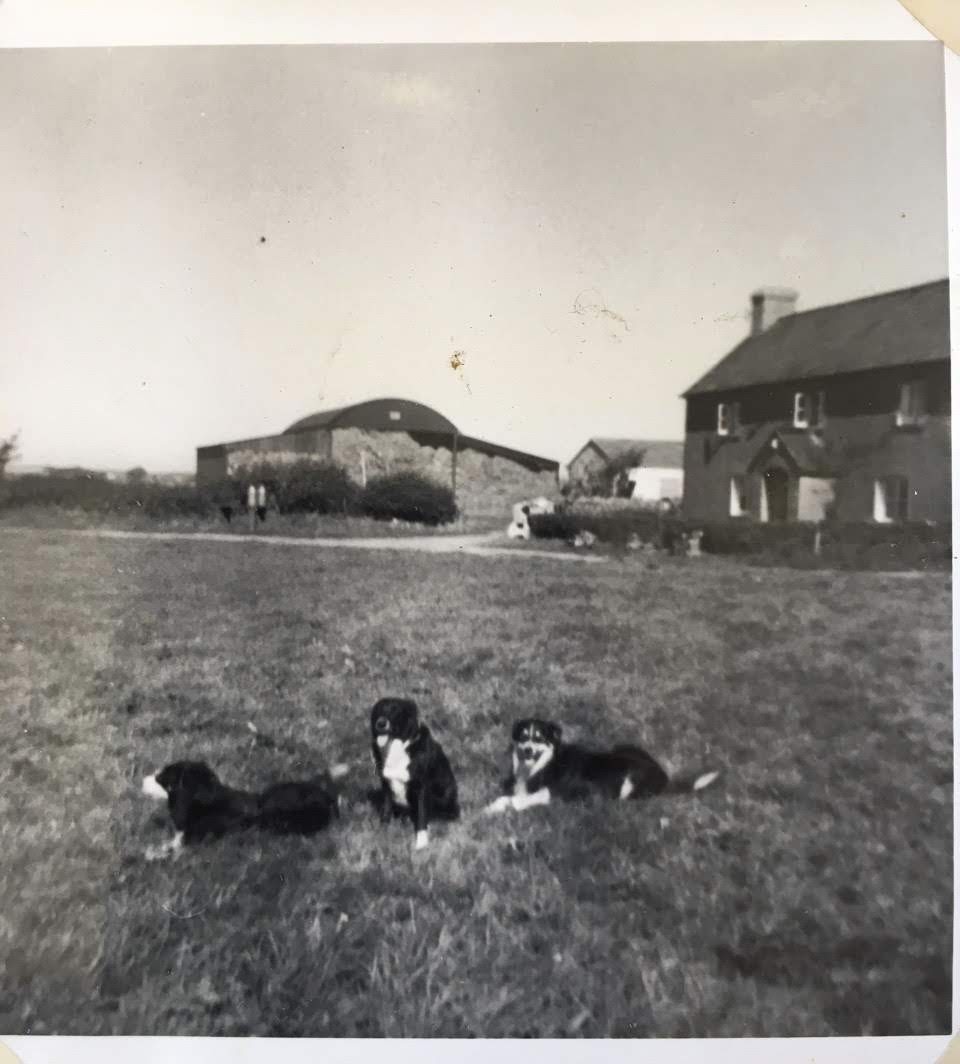
An aerial view (taken 2018):
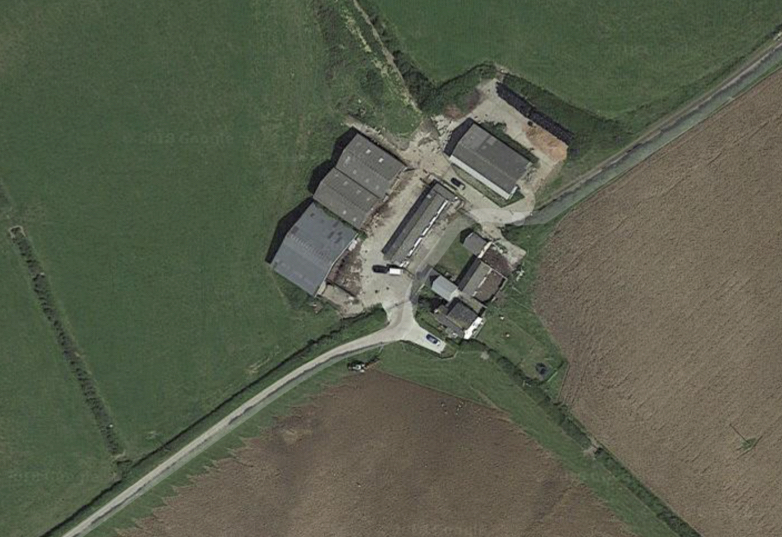
Cae Caradog Farm, Wick is identified as a likely iron age site - morphology suggests that site may be an Iron Age defended enclosure. On aerial photographs the site is visible as a circular earthwork.
"Caradog" is the given name for ‘men’ in Welsh and "Cae" means field, and "Caer" means fort. Alternatively the name may refer to Caradoc (aka Caractacus) a welsh king and ruler of the Catuvellaunui, a powerful welsh tribe - one of their main castles was at Dyndryfan (aka Dunraven) the ruins of which are located nearby. Caradoc/ Caractacus was finally defeated at The Battle of Caer Caradoc to Roman governor, Ostorious Scapula in 51 AD.
The Williamses of Cae Caradog were mentioned in the chapter on Marcross, Monknash and Wick as being a significant owner-occupier since the 18th century in the Wick area (written by Brian LL James – in Saints and Sailing Ships – edited by Stewart Williams, published 1962).
503 Wick Chapel
The Williams family were associated with, and often buried in, Wick Chapel. This was built in 1792 – initially as a Baptist chapel, and later as a General Baptist and Unitarian chapel. Some background history - The Orthodox Established Church in Wales (Anglican) was the church of the landowner and squire, often English-speaking. The strong growth of nonconformity in Wales sprang from the alienation of the Welsh people from their landlords, and, as elsewhere, from a rapid industrialisation with its attendant immigration into the towns and valleys of South Wales. Unitarian beliefs, as in England, developed within the Presbyterian and Independent congregations formed during the 17th Century and especially after the Ejection of 1662. (Source - The Unitarian Heritage – An Architectural Survey). The Act of Uniformity prescribed that any minister who refused to conform to the Book of Common Prayer by St. Bartholomew's Day (24 August) 1662 should be ejected from the Church of England. The Great Ejection saw several thousand Puritan ministers forced out of their positions by Church of England clergy, following the restoration to power of Charles II (source - Wikipedia). From the early seventeenth century a group of Dissenters decided to defy the law and meet for worship. These meetings had to be arranged to watch for the law, as these worshippers would be severely punished if they were caught. Wick Chapel was built in 1792 on land donated by local farmers. It has a gallery on three sides and a small meeting room. It is one of the few chapels in Glamorgan with a graveyard that is still being used. (Website of South East Wales Unitarian Society).
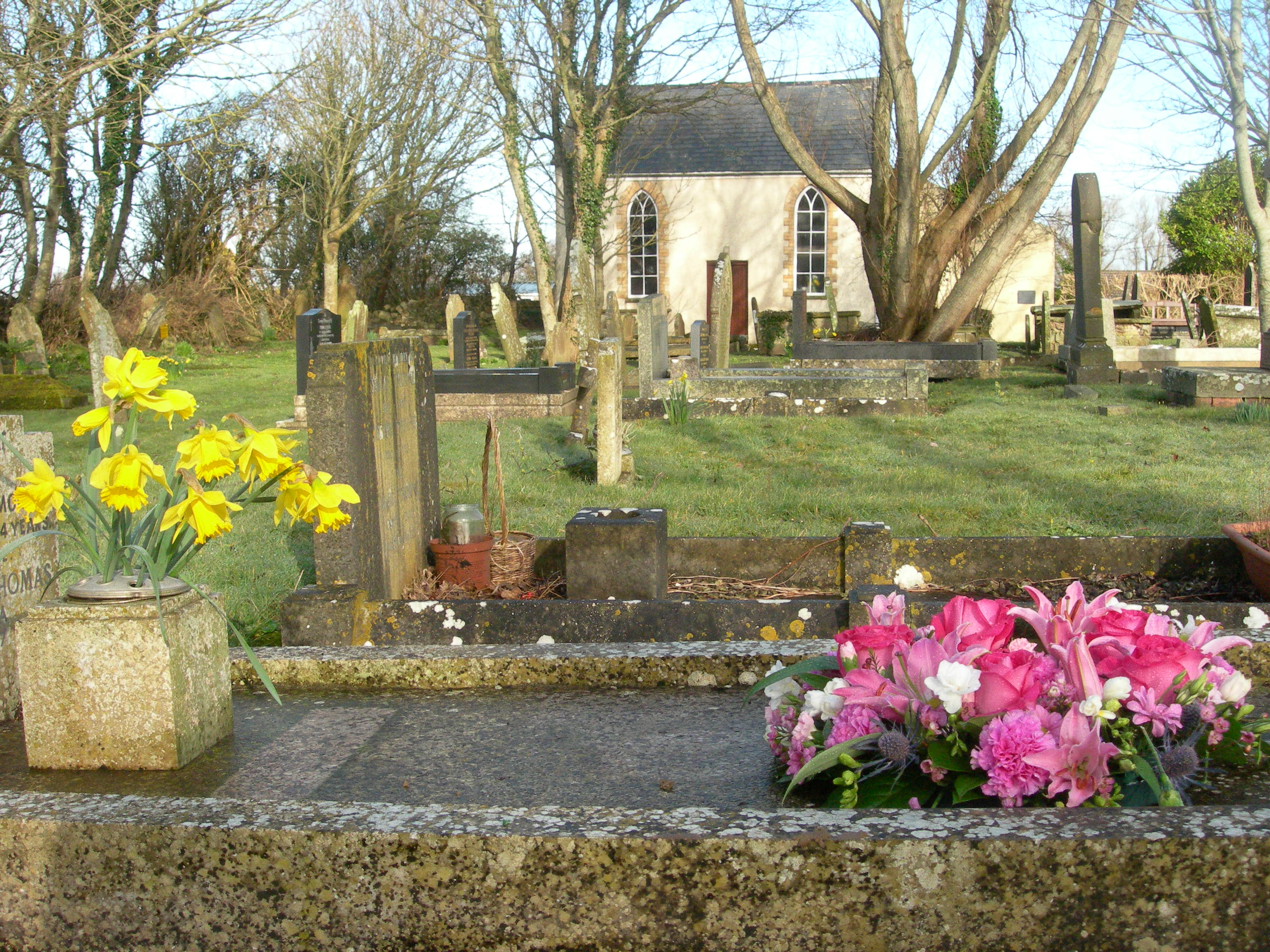
Note: There does not appear to be a record of deaths or baptisms for Wick chapel, though there is a monumental inscription index (see Glamorgan Family History Society).
504 Pitcot (also called Pitcott, Pitcoate and Pitcoed in older documents).
Abbreviations:
- NLW – National Library of Wales Archive - Aberystwyth
- GA - Glamorgan Archives, Cardiff
- GFHS - Glamorgan Family History Society
- WGA – West Glamorgan Archives, Swansea.
- NLS – National Library of Scotland – good for old maps.
- NA – National Archives, Kew, London
- CCed - Clergy of the Church of England Database
- FamilySearch is familysearch.org, the website of the church of Jesus Christ of Latter Day Saints – which provides genealogical information. Their website allows users to add family tree associations.